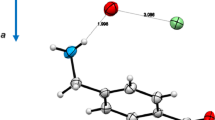Conclusions
-
1.
In the complexes B10H12L2 the B10H12 fragment behaves as a delocalized electron-deficient acceptor.
-
2.
The movement of the valence MO's of the boron atoms in the B10H12 fragment to deeper positions in the case of an NH3 ligand may be caused by an interaction involving the d orbitals of the nitrogen atom. Another explanation for the difference in the ligand-skeleton chemical bonding may be the steric effects associated with the geometry of N(Et)3.
Similar content being viewed by others
Literature cited
J. Maas Reddy and W. N. Lipscomb, J. Chem. Phys.,31, 610 (1959).
D. E. Sands and A. Zalkin, Acta Crystallogr.,15, 410 (1962).
I. A. Baidina and N. V. Podberezskaya, Zh. Strukt. Khim.,19, No. 3, 550 (1978).
I. A. Baidina and N. V. Podberezskaya, Zh. Strukt. Khim.,19, No. 3, 647 (1978).
D. S. Kendall and W. N. Lipscomb, Inorg. Chem.,12, 546 (1973).
L. I. Zakharkin, V. I. Stanko, and A. I. Klimova, Izv. Akad. Nauk SSSR, Ser. Khim., 917 (1964).
V. I. Stanko, Yu. A. Chanovskii, V. A. Bratssev, and L. I. Zakharkin, Usp. Khim.,34, 1011 (1965).
E. L. Muetterties, J. H. Balthis, Y. T. Chia, W. H. Knoth, and H. C. Miller, Inorg. Chem.,3, 3, 444 (1964).
R. J. Pace, J. Williams, and R. L. Williams, J. Chem. Soc., 2196 (1961).
L. N. Mazalov and G. F. Khudorozhko, Izv. Sib. Otd. Akad. Nauk SSSR, Ser. Khim. Nauk, No. 4, 133 (1975).
M. A. Blokhin, Methods of X-Ray-Spectroscopic Investigations [in Russian], Fizmatizdat, Moscow (1959), p. 236.
T. I. Guzhavina, Dissertation, Novosibirsk (1974).
D. E. Hyatt, F. R. Scholer, and L. J. Todd, Inorg. Chem.,6, 630 (1967).
J. H. Hall, Jr., D. A. Dixon, D. A. Kleier, T. A. Halgren, L. D. Brown, and W. N. Lipscomb, J. Am. Chem. Soc.,97, 4202 (1975).
D. N. Hendrickson, J. M. Hollander, and W. L. Jolly, Inorg. Chem.,9, 612 (1970).
D. N. Hendrickson, J. M. Hollander, and W. L. Jolly, Inorg. Chem.,8, 2642 (1969).
K. Siegbahn, C. Nordling, A. Fahlman, R. Nordberg, K. Hamrin, J. Hedman, G. Johansson, T. Bergmark, S. Karlsson, I. Lindgren, and R. Lindberg, ESCA — Electron Spectroscopy for Chemical Analysis, McPherson Instrument Corp., Acton, Mass. (1967).
T. A. Carlson, Photoelectron and Auger Spectroscopy, Plenum, New York (1975).
V. V. Volkov and V. N. Ikorskii, Izv. Sib. Otd. Akad. Nauk SSSR, Ser. Khim. Nauk, No. 6(14), 38 (1981).
R. H. Cragg, M. S. Fotuin, and N. N. Greenwood, J. Chem. Soc., A, 1817 (1970).
Author information
Authors and Affiliations
Additional information
Translated from Izvestiya Akademii Nauk SSSR, Seriya Khimicheskaya, No. 10, pp. 2248–2254, October, 1985.
Rights and permissions
About this article
Cite this article
Volkov, V.V., Il'inchik, E.A., Khudorozhko, G.F. et al. Comparative study of B10H12 (NH3)2 and B10H12 (NEt3)2 by the methods of X-ray spectroscopy. Russ Chem Bull 34, 2079–2085 (1985). https://doi.org/10.1007/BF00963238
Received:
Issue Date:
DOI: https://doi.org/10.1007/BF00963238




